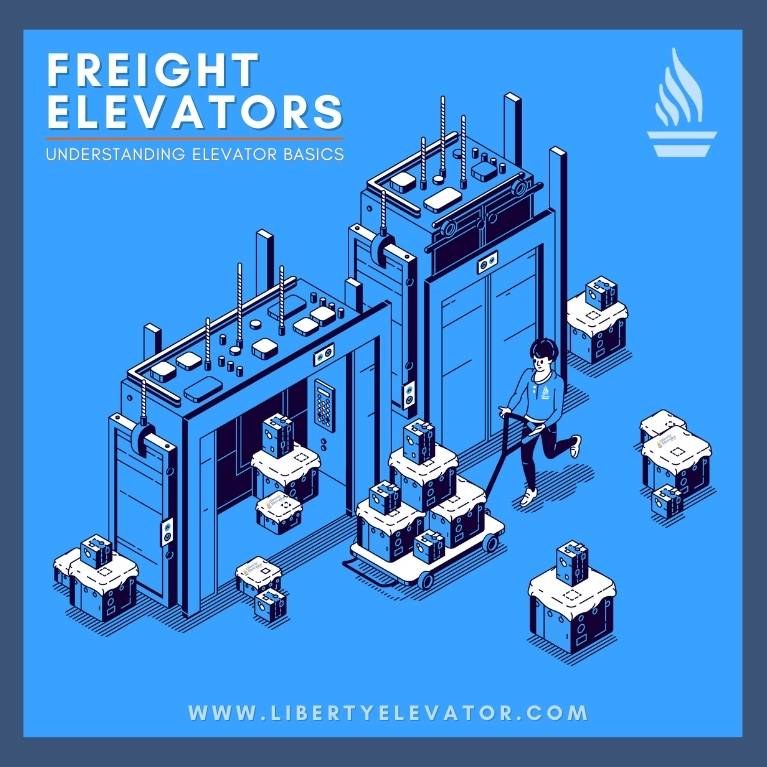Freight elevators are specifically designed to move goods and materials throughout a building in contrast to passenger elevators that are predominantly focused on moving people. Additionally, freight elevators don’t require the same fit and finish as their passenger elevator counterparts, traveling at much slower speeds and possessing much heavier load capacity, these industrial lifts tend to be made for practicality rather than aesthetic appeal. Often located near loading docks or back of house in commercial buildings, freight elevators are typically not accessible by the general public.

Understanding Freight Elevator Basics
Due in part to the harsh working conditions that a freight elevator is often exposed to, heavy duty materials are commonly used with less regard for finish and more focused on functionality as the objective is to move bulky or heavy goods within a higher weight capacity lift. Freight lifts often use cab pads to protect the interior or have built in bump rails and durable flooring, such as aluminum plate, to minimize potential damage and reduce ware.
Freight elevators can allow for much larger equipment such as forklifts or even entire vehicles to drive into an elevator. While the capacity of a traditional passenger elevator typically maxes out at 5000 lbs., freight elevators can often carry loads of 40,000 lbs. or more.
5 Classes of Freight Elevators
A freight elevator is often called a service elevator or cargo elevator and is a lift designed to carry goods, rather than passengers. Based on the required load capacity, goods being transported and the travel height, there may be several options and configurations that could be available to best service your facility.
Class A: General Freight Loading
Freight elevator with this class has the load distributed, the weight of any single piece is not more than 25% the capacity of the elevator and the load is handled on and off the car platform manually or by means of hand trucks.
Class B: Motor Vehicle Loading
Freight elevators with this class are used solely to carry automobile trucks or passenger automobiles up to the rated capacity of the elevator.
Class C1: Industrial Truck Loading
A four-wheeled vehicle may be used to load and unload in the elevator with this class. The combined weight of the vehicle and the load cannot exceed the rated capacity and may be rolled onto the platform as a single unit.
Class C2: Industrial Truck Loading
In this class, during loading and unloading, the maximum load on the platform may be up to 150% of the rated capacity. This enables the user to use a forklift to load a car with freight weighing up to the rated capacity.
Class C3: Other Loading with Heavy Concentration
During the loading and unloading process, the rated capacity must never be exceeded. Truck not usually used. Design based on material handled.
What is the Best Freight Elevator System?
Based on the knowledge you now have on the classes of freight elevators and the understanding of which unit best suits your facility’s needs, it’s time to decide what type of elevator system best fits within your building’s architecture and budget. Hydraulic elevators are relatively inexpensive and easily configured to fit within many building limitations but are only able to rise up to 6-7 stories at max. Traction elevators are more complex and expensive to install yet have the capacity to elevate your goods to virtually any height.
Learn More About Elevator Types: Links
Hydraulic Freight Elevators
When moving heavy loads a short distance, up to 60 feet of rise, a hydraulic elevator is often the most cost effective and energy efficient solution. By using a hydraulic piston to push up the platform, you allow for an extremely strong mechanical system with very few limitations for custom configuration. Typically, hydraulic elevators have shorter design and lead time for installation than traction elevators, Minimal pit and overhead requirements, and Lower installation and maintenance costs than a traction system.
Learn More About Hydraulic Elevators: Link
Traction Freight Elevator
Traction elevators operate via a pulley system, using steel ropes or belts and a counterweight to move the cabin up and down. There are two types of traction elevators: Gearless Traction and Geared Traction. Advantages of Traction Elevators include unlimited floor travel potential, significantly higher car speed vs hydraulic systems and the machinery has virtually no risk of oil contamination to your facility. Traction units are limited by the overhead clearance, above the shaft, where the elevator equipment is generally housed in a rooftop machine room.
Learn More About Traction Elevators: Link
Liberty Elevator Does the Heavy Lifting
Freight Elevators are the major arteries of your building that regulate the flow of goods and services that directly affect your business' bottom line. Liberty understands the critical nature that your service elevators play and takes all the necessary proactive measures to assure they run as efficiently as possible.
When installing a new freight elevator, modernizing your lift or maintaining your service elevator, Liberty is the elevator partner you need to safely keep your goods moving. Contact Liberty today to explore the best solutions for your property’s vertical transportation needs.
Ref: Freight Elevators

